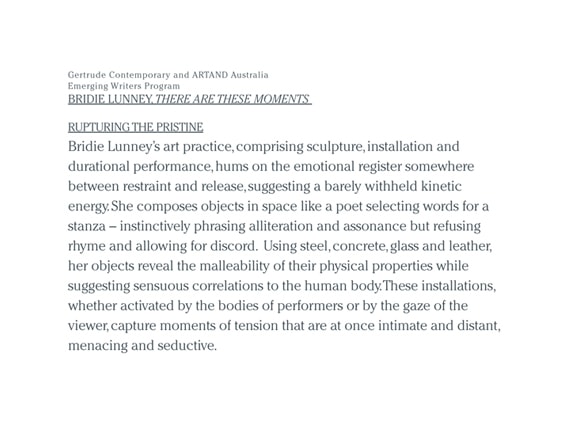programs

EMERGING WRITERS: BRIDIE LUNNEY
Download catalogue here
Rupturing the Pristine
Bridie Lunney’s art practice, comprising sculpture, installation and durational performance, hums on the emotional register somewhere between restraint and release, suggesting a barely withheld kinetic energy. She composes objects in space like a poet selecting words for a stanza – instinctively phrasing alliteration and assonance but refusing rhyme and allowing for discord. Using steel, concrete, glass and leather, her objects reveal the malleability of their physical properties while suggesting sensuous correlations to the human body. These installations, whether activated by the bodies of performers or by the gaze of the viewer, capture moments of tension that are at once intimate and distant, menacing and seductive.
This exhibition, There are these moments, has been designed as a transitive space, a holding bay for a series of objects to be deployed in a suite of exhibitions in Melbourne and Sydney: a solo exhibition at the Gertrude Contemporary project space at Melbourne Art Fair, a curated group exhibition at Platform, the John Fries and Substation prize exhibitions, and the Collins Street Aesop store.[1] The installation in Studio 12 will adapt and change throughout this exhibition, with new objects added and others removed, a process which mirrors the metamorphoses suggested by the objects themselves.
Lunney has manipulated the architecture of the space to stress this narrative of alteration and renewal. She describes the human body as “the tool we encounter the world with,”[2] and these continually configured arrangements reflect the different ways our bodies respond to context. The space is unsettled by an angled slope of pristine white tiles, suggesting both expensive interiors and the grisly potential of clinical rooms where bodies are most vulnerable: hospitals, morgues. On the wall, a row of hooks at chest height is a further gesture towards abstract functionality, either providing a temporary resting place for objects or demonstrating their absence – a large piece of animal hide, or a leather belt with pockets filled with stones. This emphatic structuring of space allows objects to command the installation with their evocative presence while confounding their implied purpose: a sprawled leather mass pinched by brass rods recalls surgical instruments, while a solid head-sized dome of aluminium reminds the viewer of the correlation between these objects and the body.
Lunney’s finely crafted sculptures play with the perception of the viewer: a pool of solid bronze appears to flow from an upturned glass like water; a loosely looped rope proves to be rigid plastic. These seductively tactile objects invite textural comparison – glass with stone, leather with steel, brass with mirror. She exploits the metamorphic properties of her materials, suggesting their potential to change under pressure – metal spills left over from the forging process, ridged spheres of concrete recalling the forms of antique light fittings used for their casting and then smashed to unveil them. In her previous exhibition for Gertrude Contemporary, a collaboration with Torie Nimmervoll called Propositions, Lunney filled a pillowcase with wet cement which, as it hardened, took on the shape of Nimmervoll’s sleeping body.[3] These subtle manipulations are instances of what Lunney describes as “rupturing the pristine.”[4]
The physical pressures involved in Lunney’s object-making echoes the physical and emotional pressures she places on her performers. In Lunney’s work for Melbourne Now, performers sustained stillness in a series of held gestures, with one performer enacting a slow catharsis by whispering secrets for hours into a silver cylinder embedded in the wall.[5]
Like secular versions of classical daemons, who performed the role of intermediaries between the divine world of the gods and humans on terra firma, these performers are interpreters for the depths of the dreaming subconscious. Like daemons they embody elements of both worlds, holding uncanny stillness, or moving through the space like haunted somnambulists.
Lunney’s sculptures belie their impermanence. Like bruises, these objects are borne from the sudden meeting of opposing forces but disappear leaving no trace. In Studio 12 they are present only briefly, crossing paths with one another, forming associations and familiarities, before they are deployed to another environment where new associations change them again. Their presence here is marked by their potential energy, momentarily still, awaiting activation by performers and new contexts. The tensions in Lunney’s work draws our attention to the discrete moments at the threshold of experience – where dreaming turns to consciousness, where pleasure meets pain, where perception becomes reality.
[1] Gertrude Contemporary at Melbourne Art Fair, 13-17 August 2014, featuring performers Lily Paskas, Shelley Lasica and Torie Nimmervoll; Platform, curated by Martina Copley, 15 August – 13 September; John Fries Award, COFA Gallery, UNSW, 9 August – 6 September 2014; Substation Art Prize 16 August – 12 October 2014; Aesop store installation, curated by Theodore Wohng, 87 Collins St Melbourne, until 17 August.
[2] Interview conducted with artist between May and July 2014.
[3] Propositions, Bridie Lunney and Torie Nimmervoll, Gertrude Contemporary, 8 February – 9 March 2013.
[4] Interview conducted with artist between May and July 2014
[5] Melbourne Now, National Gallery of Victoria, 22 November 2013 – 23 March 2014, curated by Max Delany.